
Hermit crabs are anomuran decapod crustaceans of the superfamily Paguroidea that have adapted to occupy empty scavenged mollusc shells to protect their fragile exoskeletons. There are over 800 species of hermit crab, most of which possess an asymmetric abdomen concealed by a snug-fitting shell. Hermit crabs' non-calcified abdominal exoskeleton makes their exogenous shelter system obligatory. Hermit crabs must occupy shelter produced by other organisms, or risk being defenseless.
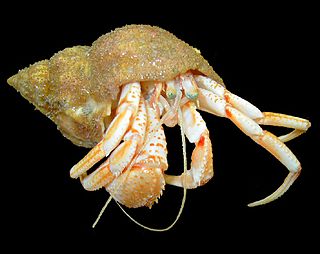
Pagurus bernhardus is the common marine hermit crab of Europe's Atlantic coasts. It is sometimes referred to as the common hermit crab or soldier crab. Its carapace reaches 3.5 centimetres (1.4 in) long, and is found in both rocky and sandy areas, from the Arctic waters of Iceland, Svalbard and Russia as far south as southern Portugal, but its range does not extend as far as the Mediterranean Sea. It can be found in pools on the upper shore and at the mean tide level down to a depth of approximately 140 metres (460 ft), with smaller specimens generally found in rock pools around the middle shore and lower shore regions, with larger individuals at depth. P. bernhardus is an omnivorous detritivore that opportunistically scavenges for carrion, and which can also filter feed when necessary.

Sea anemones are the marine, predatory animals of the order Actiniaria. They are named after the anemone, a terrestrial flowering plant, because of the colourful appearance of many. Sea anemones are classified in the phylum Cnidaria, class Anthozoa, subclass Hexacorallia. As cnidarians, sea anemones are related to corals, jellyfish, tube-dwelling anemones, and Hydra. Unlike jellyfish, sea anemones do not have a medusa stage in their life cycle.

Adamsia is a genus of sea anemones in the family Hormathiidae. Species in this genus are mutually symbiotic with hermit crabs. The anemone gets a place to live and discarded scraps of the crab's food in exchange for its help in the crab's defence. As these anemones grow, they secrete a horny membrane, known as a carcinoecium, which overlies the crab's original snail shell and expands the living space of the crab. This means the anemone does not have to change substrate and the crab does not have to seek a larger shell as they both grow.
Periclimenes dardanicola is a species of shrimp found in the western Pacific Ocean. It lives in association with sea anemones that live on the gastropod shells carried by hermit crabs. It was first named by Alexander J. Bruce and Junji Okuno in 2006. It is mainly white, and grows up to a carapace length of 4 mm (0.16 in).

Dardanus calidus is a species of hermit crab from the East Atlantic and Mediterranean Sea.

Calliactis parasitica is a species of sea anemone associated with hermit crabs. It lives in the eastern Atlantic Ocean and Mediterranean Sea at depths between the intertidal zone and 60 m (200 ft). It is up to 10 cm × 8 cm in size, with up to 700 tentacles, and is very variable in colour. The relationship between C. parasitica and the hermit crab is mutualistic: the sea anemone protects the hermit crab with its stings, and benefits from the food thrown up by the hermit crab's movements.
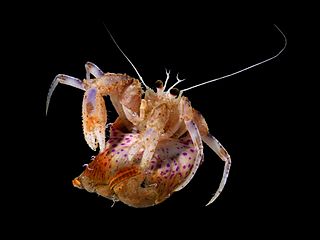
Adamsia palliata is a species of sea anemone in the family Hormathiidae. It is usually found growing on a gastropod shell inhabited by the hermit crab, Pagurus prideaux. The anemone often completely envelops the shell and because of this it is commonly known as the cloak anemone or the hermit-crab anemone.

Pagurus prideaux is a species of hermit crab in the family Paguridae. It is found in shallow waters off the northwest coast of Europe and usually lives symbiotically with the sea anemone Adamsia palliata.

Calliactis polypus is a species of sea anemone in the family Hormathiidae. It is usually found living on the surface of a sea snail shell in which a hermit crab is living.

Allopetrolisthes spinifrons is a species of porcelain crab. It displays "hypercarcinisation", whereby the resemblance to a true crab is enhanced by sexual dimorphism of the abdomen. It lives along the Pacific coast of Peru and Chile, as a symbiont of a sea anemone.
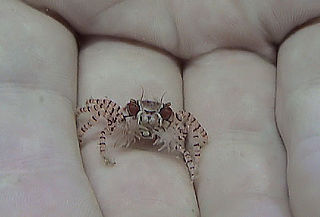
Triactis is a genus of sea anemone in the family Aliciidae. It is monotypic, having only one species – Triactis producta. This is found in shallow waters in the Indo-Pacific where it lives on the seabed, rocks and corals. It derives much of its energy needs from the symbiotic algae it contains. It also forms a mutualistic relationship with small Lybia crabs.
Dardanus venosus, the starry-eyed crab or stareye crab, is a species of hermit crab in the family Diogenidae. It occurs in shallow water on the eastern coasts of America from Florida southward to Brazil. It is sometimes kept in reef aquaria.
Calliactis tricolor, the tricolor anemone or hitchhiking anemone, is a species of sea anemone in the family Hormathiidae. It occurs in the Caribbean Sea and the Gulf of Mexico. It can be found attached to rocks but is often attached to a living crab or mollusc or an empty shell occupied by a hermit crab.

The thinstripe hermit crab, Clibanarius vittatus, is a species of hermit crab in the family Diogenidae. It is found in the Caribbean Sea, the Gulf of Mexico and the western Atlantic Ocean.
Calitoxin, also known as CLX, is a sea anemone neurotoxin produced by the sea anemone Calliactis parasitica. It targets crabs and octopuses, among other invertebrates. Two isoforms have been identified, both of which are formed from precursors stored in the stinging cells of the anemone. Once the toxin is activated and released, it causes paralysis by increasing neurotransmitter release at invertebrate neuromuscular junctions. Along with several other toxins derived from anemones, CLX is useful in ion channel research. Certain structural aspects of calitoxin are dissimilar from sea anemone toxins that also target the sodium ion channels. Other toxins resembling calitoxin function in completely different ways.
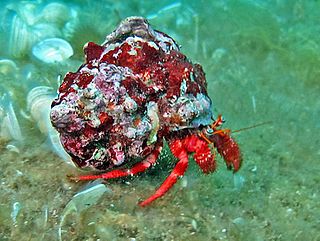
Dardanus arrosor, the red reef hermit or Mediterranean hermit crab, is a species of hermit crab.
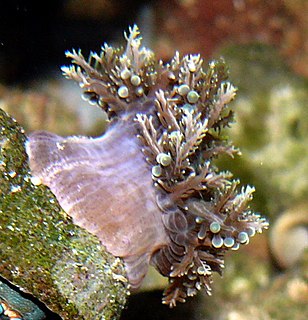
Thalassianthus aster is a species of sea anemone in the family Thalassianthidae. It dwells in a number of habitats, even existing symbiotically on top of other motile invertebrates such as hermit crabs in a relationship similar to the pom pom crab. Its nematocysts contain a Type-II Na+-channel toxin known as δ-TLTX-Ta1a according to the currently developing systematic nomenclature for peptide and protein toxins from sea anemones.
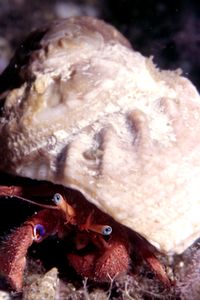
Paguristes eremita, the eye spot hermit crab, is a species of hermit crab in the family Diogenidae. It is found in the Mediterranean Sea.
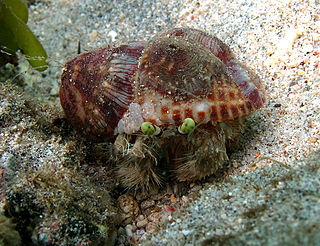
Dardanus deformis is a species of nocturnal hermit crab that is found in the Indo-Pacific. Its common name is pale anemone hermit. The species is known to transfer sea anemones from one shell to another when it moves to a different shell. It can be kept in an aquarium.













